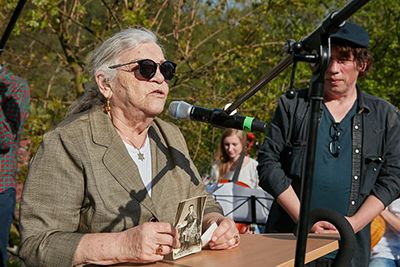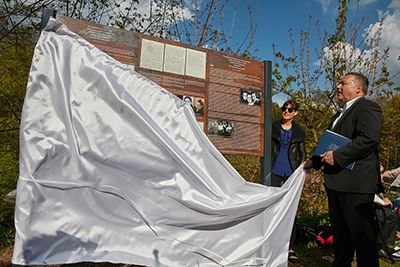Memory in Trutnov
The sun was setting when we pulled up to a fenced-in lot behind which stood a crumbling redbrick textile factory. There was a sign on the front gate that read “For Sale.” It wasn’t the kind of signage I expected to find on the site of a former women’s forced labor camp where my mother and 350 other Polish Jewish girls had been worked nearly to death, making thread used to sew Nazi uniforms. Gabersdorf survivor Sara Sliwka Bialas-Tenenberg, a resident of Berlin, had volunteered to revisit this painful spot to show me what my late mother never could. My mother had changed her name from Hela Hocherman to Tamar Fromer Fox to bury this past, which I was now determined to uncover.
“She had beautiful red hair and big brown eyes,” Sara recalled of my mother, as we climbed the creaky factory stairs that threatened to buckle under and she led me to the second floor pointing to where my mother worked processing raw flax into giant spools of thread. “I cleaned the flax and brought it to her.”

“It was my happiest and my saddest moment,” she said recalling liberation. “I learned everyone in my family was murdered, that I was now alone in the world with no home to return to.”
She drifted from Poland to France and then to Israel where she lived with many other survivors, who also suppressed their wartime pasts. After losing a son, she moved to Germany, where she knew no other survivors and was overcome by the trauma of her wartime memories. I knew this trip wasn’t easy for Sara, but I knew it was as important for her as it was for me. She sought validation after a life of suppressed suffering, and I sought clarity about a buried past that kept me from feeling whole.
Though I was filming Sara for my book and film, “By A Thread,” committing her story to posterity, I saw how the “For Sale” sign at the front gate nearly knocked the wind out of her. The Gabersdorf girls, and the former prisoners of all 11 Trutnov camps, deserved better and I vowed I’d do something about it.
I tried to contact the mayor of Trutnov, Czech Republic, to ask him to put up a plaque and mark this turf. Locals, apparently, had no idea that the textile mills in their backyards had once been sites of Holocaust persecution. But the mayor was away and never got back to us. Amidst the various commemorations that took place in 2015, marking the 70th anniversary of the liberation of Auschwitz and Dachau, I thought of my mother and my vow to Sara. Since our trip a few years earlier, I had interviewed dozens of other Gabersdorf survivors, discovered there had been 10 other women’s slave labor camps in Trutnov, then Trautenau, Sudetenland and that the 5,000 Polish Jewish women trafficked to Trutnov were among the first to be imprisoned in Nazi camps and the last to be liberated, on May 8th--9th, 1945. Didn’t they deserve to be honored, too?
I reached out again to Trutnov mayor Ivan Adamec and told him I wanted to commemorate the Polish Jewish women of all 11 Trutnov camps on the 70th anniversary of their liberation. This time he responded and said he would commit to erecting a marker on the site of the former Gabersdorf. It wasn’t ready in time for that trip, but a year later, I stood on the spot I had visited a few years earlier with Sara and watched her speak, a new woman, proud and rehabilitated by the recognition she so rightly deserved, speaking with conviction and singing “The Partisans’ Song,” along with Karsten Troyke, the Yiddish singer she trained who initially connected me to her in 2011.
I also brought with me my oldest child, Leo, my Israeli cousin Yehuda and his wife, Riana, whose parents were Czech, and their son Ofer. Before I uncovered my mother’s Gabersdorf past, they had traveled through Trutnov, saw the many abandoned factories and figured they had been remnants from the country’s communist past. Who knew my mother and most of the women who survived the Holocaust from Zaglembie, the southwest corridor of Poland near the German border, had been trafficked to this region and others throughout Sudetenland and Silesia, and had survived in these factories, clinging to life by a thread?

At the unveiling ceremony, she spoke of her drive to survive, the sisterhood that enabled the girls to endure the brutality of the Nazi slave labor system and to form tight bonds that lasted long after liberation. She also spoke of smuggling potatoes they would warm by the factory heater, knitting socks from stray threads and how their Nazi commander had wired the periphery of the camp with dynamite on the eve of their liberation, telling the girls that this would be their last night alive.
“We didn’t know if we were going to live or die,” she said, also recalling the sadism of an SS guard who would beat her to a pulp each day after her shift. “Imagine living like that for three years. It was easier to die, as my friend Pepi did when she learned her family had been murdered. I promised her that if I survived, I would tell the world about our suffering.”
Her book, “I Kept my Promise,” is dedicated to Pepi. But it’s the spirit of survivors like Gerda and Sara, the talkers and the silent ones, like my mother, who never spoke of their past out of misplaced guilt and shame, but who were so brave, so hopeful, so young and determined, who inspired me to see this monument through completion. What my mother couldn’t tell me, I feel obligated to discover and share. The Trutnov monument is the only one outside of Ravensbruck and Valory, Czech Republic, that honors women victims of Nazi slave labor. May it not be the last Holocaust monument that recognizes women.